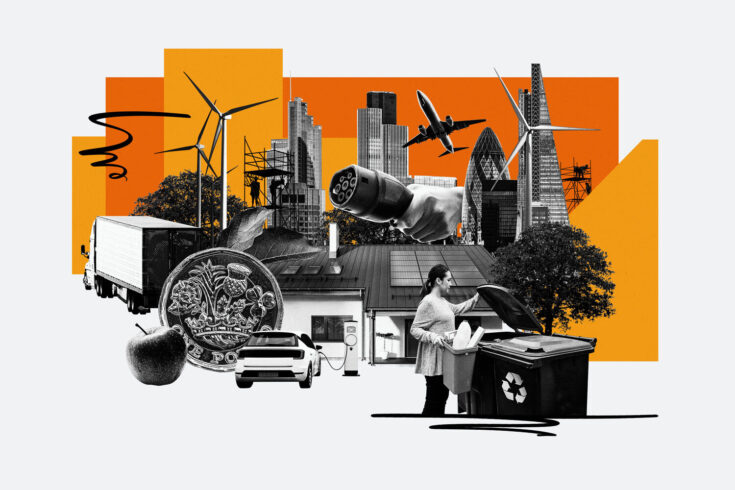I have a personal connection to the UK’s net zero 2050 target. My retirement will coincide with the start of the 2050s and what an achievement it would be if I could look back and say I helped make net zero a reality.
The clock is ticking. We have less than 3 decades to do this and here is how.
The challenge of achieving net zero greenhouse gas emissions in the UK and globally to limit further climate change is profound.
We need to change the way we live our lives, including how we make, use, and consume products, materials, and food, how we travel and work, and how we use our natural resources and our land.
The solution is 3-fold
We must do 3 things. First, reduce our energy demand and make our products, materials and food more sustainable. Second, we must replace carbon intensive systems with low and zero carbon alternatives. Third, we must remove emissions that are unavoidable through greenhouse gas reduction technologies and carbon capture.
These touch on every aspect of our lives and if implemented effectively could help address some of the biggest challenges facing society today including the cost-of-living crisis and our energy security. Wider benefits include addressing regional inequalities, increasing our supply chain resilience, environmental sustainability, biodiversity, resilience to extreme weather events, health, and UK and global prosperity.
A system of solutions
There is no silver bullet. No single technology can do this. We need a system of technological, environmental, and social solutions that work in unison.
We must reduce energy consumption through social and technological measures, including making our homes more efficient through better insulation. We must improve resource efficiency, including in our major manufacturing processes such as for steel, cement, aluminium, and chemicals, switch carbon intensive feedstocks for clean alternatives, and we need changes in how we travel.
We must change how we produce, distribute and store energy by drawing on renewable technologies, nuclear power, long and short-term storage solutions, and alternative fuels such as hydrogen.
All these will be required in some form due to our diverse energy needs, but all come with their own limitations and need us to rethink our energy system.
We need ways to capture, store and make use of emissions that continue to be produced through greenhouse gas reduction technologies, nature-based solutions (such as afforestation), and carbon capture utilisation and storage.
The role of incentives and disincentives
Let’s take the challenge of decarbonisation of passenger cars as an example.
Electric car sales in the UK increased by 40% in 2022, and there are now an estimated 660,000 electric cars on the road in the UK and 445,000 plug-in hybrids.
How did we get here? This has been driven by fleet-wide CO2 emission targets for automotive manufacturers first introduced in 2014 by the EU.
To respond, automotive manufacturers have had to shift their businesses away from the internal combustion engine and innovate to continue to operate in the market.
In this instance, regulation has been used to create a market opportunity and achieve wide-scale decarbonisation, contributing to net zero and enabling economic growth.
Research breakthroughs in lithium-ion battery technology pioneered in the UK alongside improvements in supply chain readiness meant batteries offered the most viable option.
This coupled with factors such as cost, availability and manufacturability have made battery electric vehicles the go-to solution for passenger cars.
How has the UK secured one of the largest offshore wind generation capacities in the world?
Decades of investment in offshore wind research and innovation has made us a leader in offshore wind.
Research breakthroughs through our investments meant the scale-up and deployment of the technology became viable, and the largest offshore wind developers and manufacturers have been attracted to the UK.
However, what unlocked wide-scale deployment and created the market opportunity was the introduction of ‘contracts for difference’.
These contracts ensure generators receive a fixed, pre-agreed price for the low-carbon electricity they produce for the duration of the contract.
This is known as the ‘strike price’ and has acted as an incentive for companies to invest in offshore wind energy generation in the UK and achieve large scale-deployment of a renewable energy generation technology.
The opportunity
Our sustained investment in research and innovation has secured technologies such as offshore wind, batteries, hydrogen, carbon capture, whole systems understanding and energy and resource efficiency solutions. These are already helping the UK to decarbonise.
Our interventions continue to deliver opportunities for UK and global businesses to exploit. They help to solve domestic challenges and offer the opportunity for us to export products, systems, and services to the rest of world.
World-leading UK researchers and innovators supported by our funding are working to solve today’s most pressing challenges and ensuring we are at the forefront of developing next-generation solutions.
From pushing the boundaries in the realisation of fusion energy and perovskite-based solar technology to carrying out applied research to reduce our reliance on single-use plastics and everything in between.
My job is to ensure this continues and to ensure we have the researchers, innovators, partnerships, infrastructures, and investments to make this a reality.
The secret
But what do the examples from offshore wind and passenger cars tell us? They tell us that we need incentives and disincentives to achieve our net zero targets, to exploit our world-leading research and innovation, and to bring the wider benefits to bear.
They are necessary to drive whole-system change and create market opportunities for businesses, and they need to be used intelligently.
So here it is, the secret to unlocking net zero. It is through the effective use of policy, regulation, and legislation to create market opportunities, coupled with a diverse suite of technological, environmental, and social solutions that businesses can draw on to shift their products, systems, and services to meet the need.
It isn’t rocket science, but it is a whole-system challenge that we can only navigate if we work together.




